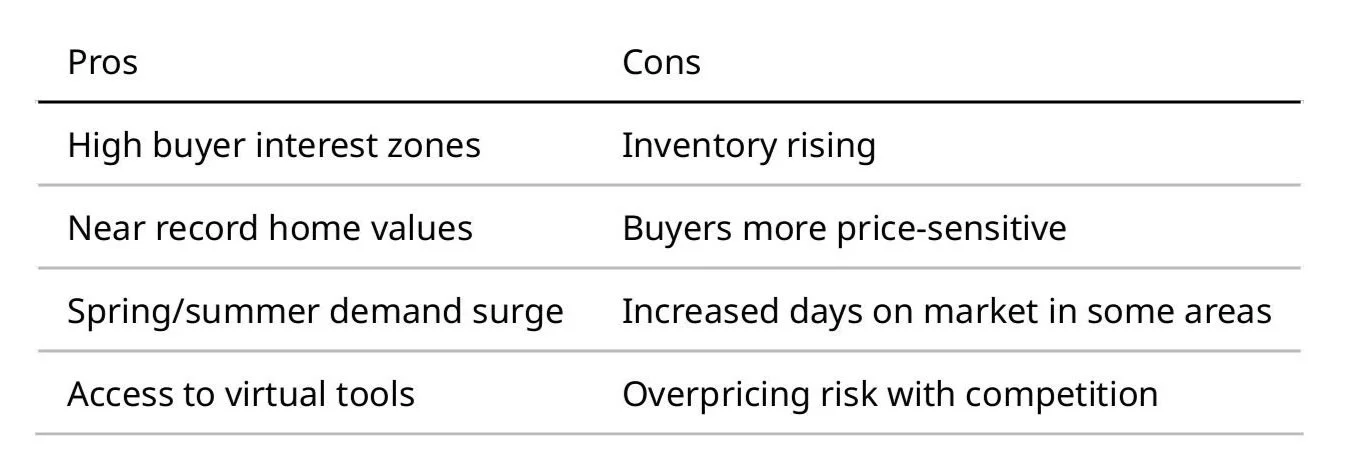TL;DR
Connect early with a trusted San Diego real estate expert to understand market timing, pricing trends, and local buyer behavior.
Pre-listing prep should include decluttering, home staging, market research, minor repairs, and selecting a listing strategy that suits your goals.
In 2025, with inventory rising across San Diego, sellers need to be especially strategic to stand out and maximize value.
Why the First Step is NOT Listing Immediately
It’s tempting to jump straight to listing your property. But the actual first step to selling your San Diego home is getting prepared both emotionally and strategically.
Think of selling your home like launching a product: without research, positioning, and presentation, you risk poor offers or a stalled listing.
Real Talk From a Seller in Pacific Beach
Earlier this year, a seller in Pacific Beach shared their story on a real estate forum: "I spent $1,500 decluttering, staging, and replanting our front yard with succulents. We had five offers in three days and sold 8% over asking." That simple first step - a strategic mindset shift - made all the difference.
What Should You Do First Before Selling Your Home in San Diego?
1. Consult a Local Real Estate Agent
A quick consultation with a local expert (like the Scott Cheng Team) gives you:
A price range based on current comps
Staging advice tailored to your home’s layout
Tips on ideal listing timing based on local trends
2. Research San Diego Market Conditions
The San Diego housing market in 2025 shows increasing inventory (+61% YOY) and softening competition. Timing your entry is key.
Median Listing Price: $990,000
Hot Zones: North Park, La Mesa, and Carmel Valley
Understanding these neighborhoods is key. For instance, North Park continues to attract young professionals due to its walkability and trendy eateries, while La Mesa offers more space and suburban charm ideal for families. Carmel Valley is a favorite for its top-rated schools and newer homes.
3. Pre-Sale Home Inspection
While not mandatory, a pre-sale inspection gives sellers an upper hand. It identifies potential issues ahead of time, allowing repairs to be handled proactively instead of under buyer pressure. It also communicates transparency and helps prevent deals from falling through during escrow.
4. Know Your Buyer Pool
Understanding who your likely buyers are can shape your preparation strategy. Are you marketing to first-time buyers, military families, or retirees? For example:
Downtown condos often attract professionals seeking convenience.
East County homes may appeal to families needing more space.
Coastal homes cater to luxury buyers looking for lifestyle and views.
How to Prepare Your Home Before Listing
Declutter & Deep Clean
Buyers need to picture themselves in your space. Store personal items and remove 30% of your furniture.
Minor Repairs & Paint
Neutral tones and small fixes (leaky faucets, loose handles) boost value perception.
Home Staging: Worth the Effort
San Diego homes with professional staging spend 73% less time on market, especially in luxury neighborhoods like Del Mar and La Jolla.
Enhance Curb Appeal
A fresh front door color, native landscaping like succulents and drought-resistant plants, and clean walkways make a strong first impression. Homes in San Diego with standout curb appeal typically fetch 5–10% more than those that don’t.
Professional Photography and Virtual Tours
With over 90% of buyers starting their home search online, high-resolution images and 360-degree virtual tours help your listing stand out. Drone shots showing proximity to beaches, schools, or parks can also highlight lifestyle value.
Marketing Your San Diego Home
Crafting the Perfect Listing Description
Your MLS listing description should go beyond square footage and bedroom counts. Highlight unique features like ocean views, custom kitchens, outdoor entertaining areas, or recent renovations. Use emotional language to paint a lifestyle picture.
Social Media & Email Campaigns
An aggressive digital marketing strategy boosts exposure. Facebook, Instagram, and YouTube campaigns paired with targeted email blasts can reach motivated buyers actively searching in the San Diego area.
Open Houses & Private Showings
Coordinate with your agent for maximum visibility. Weekend open houses can attract a wide pool, while private weekday showings cater to serious, qualified buyers.
Timing the Market: When is the Best Time to Sell in San Diego?
The optimal time to list is generally between late February and June. The spring market sees higher buyer activity and quicker sales.
However, in 2025, rising inventory could create a more balanced market, offering opportunities for well-priced homes with strong visual appeal.
Seasonal Tips:
Spring: Highest buyer demand.
Summer: Families rushing to move before school starts.
Fall: Less competition, but fewer active buyers.
Winter: Motivated buyers, potential tax incentives.
Navigating Offers and Negotiations
When offers come in, review more than just the price:
Contingencies: Fewer contingencies often mean a smoother closing.
Buyer’s financial strength: Pre-approved buyers with higher earnest money deposits are preferable.
Closing timeline: Choose one that aligns with your move-out plan.
Counteroffers are common, so lean on your real estate advisor to strategically adjust terms while maintaining leverage.
Dealing With Multiple Offers
In hot zones like South Park or Clairemont, multiple offers may come in quickly. Your agent can guide you in evaluating:
Escalation clauses
Appraisal gaps
All-cash vs. financed offers
Legal and Financial Prep Before Selling
Gather Your Paperwork
Original purchase documents
Mortgage payoff information
Homeowners association (HOA) documents
Recent utility bills and property tax records
Understand Seller Costs
Expect to pay 6–8% in total selling costs, including:
Real estate agent commissions
Escrow fees
Title insurance
Possible repairs or credits
Also, factor in capital gains tax if applicable. A good agent or tax advisor can help assess your specific case.
Pros and Cons of Selling in Today’s San Diego Marke
FAQs About Selling a Home in San Diego
Do I need to get a pre-inspection before listing?
Not required, but smart. It gives you a heads-up on any deal breakers and helps avoid renegotiation surprises.
Is now a good time to sell with rising inventory?
Yes - but only if you price competitively and present well. Don’t go in blind.
How do I choose between a flat-fee and full-service agent?
Flat-fee can save money but offers minimal service. Full-service (like Scott Cheng’s team) brings staging, negotiation, and marketing muscle.
Should I sell my San Diego home as-is or make upgrades?
It depends on the condition and your timeline. Strategic cosmetic upgrades (paint, lighting, landscaping) usually offer the best ROI without a full renovation.
How long does it take to sell a house in San Diego in 2025?
The average time on market is currently 21–35 days for well-prepped homes. In high-demand neighborhoods, it can be under two weeks.
What paperwork do I need to sell my house in California?
Key documents include a property disclosure statement, title report, purchase agreement, natural hazard report, and closing statement. Your agent and escrow officer can help organize these.
Can I sell my house while living in it?
Yes, and many do. Just be prepared for showings, keep your home staged, and limit clutter. Weekday evening showings and weekend open houses offer flexibility.
Ready to Sell? Let’s Talk
Before you pick up a paintbrush or schedule an open house, talk with a trusted San Diego real estate advisor. The first step isn’t just tactical - it’s strategic.
Free consultation + home valuation included.
Contact Scott Cheng today for a free consultation or home valuation.
Call or text (858) 408 0002 • scott@scottchengteam.com










